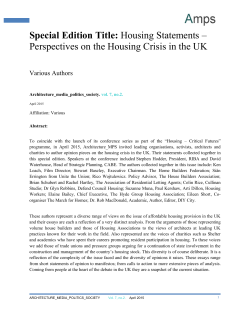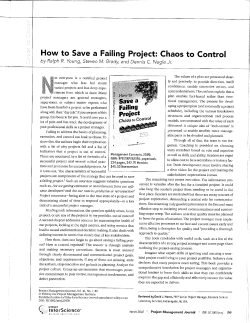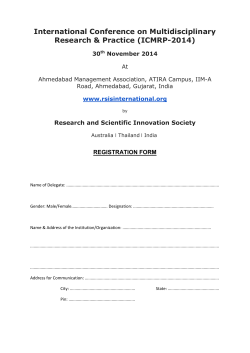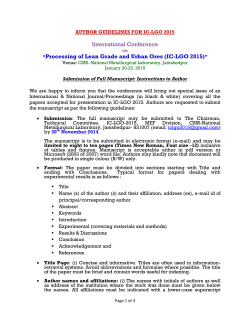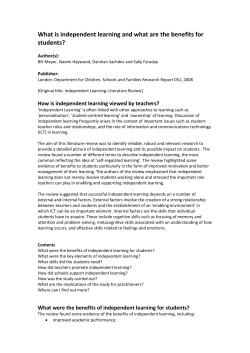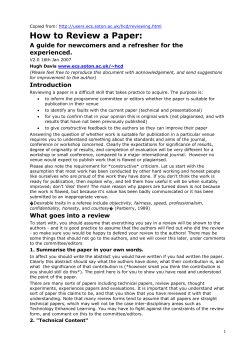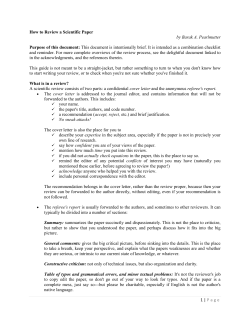
Authors` Guide and Tansliteration Symbols
International Journal of Arabic-English Studies (IJAES) Vol. 14, 2013 Authors' Guide Length of Manuscript 1. Articles should normally be no longer than 9,000 words. 2. Book Reviews should be in the range of 500– 750 words. 3. Notes and Discussion should normally be no longer than 2000 words. No abstract is required for such pieces of writing. Abstracts A short abstract of up to 200 words should appear on the first page. Submission of Manuscript Manuscripts submitted for publication in IJAES should not have been published previously or be under consideration for publication elsewhere in any form. Articles should be sent as email. Contributors are kindly requested to observe the following: 1. Do not send your article in the body of an email. Send it only as an attachment. 2. We can only accept attachments which are formatted as Microsoft Word document, with a file name yourname.doc, e.g. Hamdan.com 3. Please send two attachments. The one called yourname1.doc, e.g. Hamdan1.com should contain your full name, rank, affiliation, postal and email address, fax number, and the title of your article; the other attachment called yourname2.doc, e.g. Hamdan2.com should contain only the article without any reference to you, the author. This is the text that will be used for our blind reviewing process. Style Authors are particularly requested to observe the conventions listed below. 1. References Please give full bibliographical details of references and list them in alphabetical order of author, following the style of the examples given below. Only references mentioned in the text should appear in the list of references at the end of the article (bibliography). Books: o Author’s surname are followed by comma and first name (and full points) in bold, with a word space between two or more first names/initials. Initials of first names are used only if they appear as such on the original work. o Spell out first names of authors and editors where known. o For books with more than one author, the first names and/or initials come first on second, third, etc. authors. o Date is enclosed between parentheses followed by a full point. 199 Authors’ Guide and Transliteration Symbols o o Authors with two books in same year should be labeled a and b, on the basis of the alphabetical order of the title (immediately after date, no space, e.g. 1991a). Book titles (in Roman) should in italic; main words have initial capitals including subtitles. Example: Little, Arthur L., Jr. (2000). Shakespeare’s Jungle Fever: NationalImperial Revisions of Rape, Race and Sacrifice. Stanford: Stanford UP. Bloor, Thomas and Meriel Bloor. (1995). The Functional Analysis of English: A Hallidayan Approach. London: Arnold. Articles: o Titles of journal articles appear in Roman with single inverted commas o First word only has initial capitals except for names: Subtitles also start with a capital letter. o Full point is provided after the final inverted comma. o If an entry is a paper from an edited collection, put the title in Roman with single inverted commas. o Journal titles are in italic, followed by a comma; main words have initial capitals o Please check that all details have been included: volume, issue (if available), page numbers. Edmonds, Philip and Graeme Hirst. (2002). 'Near-synonymy and lexical choice'. Computational Linguistics, 28 (2):105-144. Edited books: o If an edited book is referred to several times, put the full details as a separate entry with just authors and dates elsewhere; however, o If it is referred to only once, put the full details with the entry for the paper. o Please check that all works referred to have their full details somewhere. Examples Moon, Rosamund. (1998). 'Frequencies and forms of phrasal lexemes in English'. In Anthony Cowie (ed.), Phraseology: Theory, Analysis and Applications, 79-100. Oxford: OUP. Sapir, Edward (1929). ‘The status of linguistics as a science’. Language 5:207–14. Reprinted in David Mandelbaum (ed.), Selected Writings of Edward Sapir, 160– 66. Berkeley: University of California Press, 1949. Bibliographical references in the text: References are to be made in the text by giving in parentheses the name of the author, year of publication, and, where relevant, the page(s) referred to: 200 International Journal of Arabic-English Studies (IJAES) Vol. 14, 2013 (Setecka 2004:5-18). If the author’s name is part of the text, use the form: Setecka (2004:11) maintained that . . . . o No comma between author’s name and date. o Separate works referred to in the same parentheses should be in chronological order: (Whitney 1867; Hymes 1981). Separate them with semicolons as follows: (Fisiak 1985; Wenden 1986; Swain 1995). Initials should be used before an author’s name only when an article refers to more than one author with the same surname o When a work written by two or more authors is referred to, all names should be given in the first citation: (Weinreich, Labov and Herzog 1968). In later citations, use an abbreviated form: (Weinreich et al. 1968). o If more than one work was published in the same year, list these alphabetically by author’s name as follows: (Farghal 1985; Fisiak 1985; Asfour 1994; Bakir 1994; Atari 2004; Malzahn 2004) 2. Headings and subheadings o No more than three levels of heading below the title. o Headings should be numbered consecutively using Arabic numerals and so should subheadings (e.g. 2.1.1; 2.2.1; 2.3.1; etc.) o In headings and subheadings first word only has initial capitals. 3. Footnotes o Short notes can appear in the text within brackets. o There will be no footnotes on individual pages. o Longer notes should be collected together at the end of the article. Please number notes consecutively; use Arabic numerals and give clear superscript numbers in the appropriate places. 4. Paragraphs and long quotations o No line space should be left between paragraphs. o The first line of new paragraphs should be indented, except straight after a heading. o Quotations of more than three lines should be displayed and indented. Check that page numbers of the source have been provided. 5. Tables and figures Tables and Figures should be inserted in the text. A separate file is also useful. Each Figure and Table should be clearly labeled with number and caption. They should be numbered Figure 1, Figure 2, Table 1, Table 2, etc. 201 Authors’ Guide and Transliteration Symbols Transliteration Symbols for Arabic Vowels and Some Consonants Arabic Alphabet Symbol Example Meaning ء ʔ ʔamal hope ث th c tha lab fox ج j jamal camel ح h hub love خ kh khubz bread ذ dh dhahab gold ز z zi:t oil ش sh shams sun ص s sayf summer ض d dayf guest ط t ti:n mud ظ TH THuhr noon ع c غ c abd slave gh gharb west ق q qalam pencil و w ward rose ي y yawm day )(فتحة a kataba he wrote ُ )(ضمة u kutub books ِ )(كسرة i sin tooth ى/مد طويل ا a: ka:tib writer ضمة طويلة و u: fu:l beans كسرة طويلة ي i: fi:l elephant Diphthongs aw mawt death ))أصوات علة مركبة ay bayt house 202
© Copyright 2025

